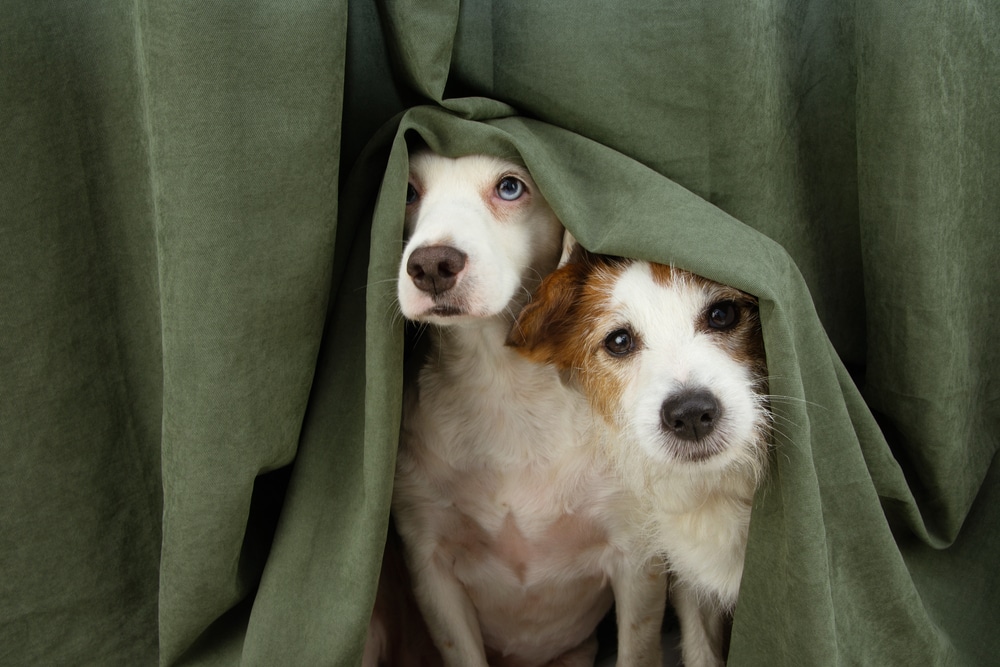Dogs are full of fun and curiosity, but sometimes they might get scared of things, depending on the situation and past experiences. So, It’s important to recognize signs of fear in your pup, so you can help them better understand it and learn how to cope with their fear. But what are the signs your dog is scared?
Dogs show they’re scared in many ways, and these signs can be specific to the individual. The most common signs of fear are panting, hyperactivity, cowering, tail tucked between the hind legs, and hiding. Other signs can include yawning, whale eyes (a fearful expression where the whites of their eyes show), trembling or shaking, lack of appetite, and licking their lips. If you notice any of these signs in your pup, it’s important to recognize the fear and take steps to help them feel more comfortable and safe.
Table of Contents
10 Signs A Dog Is Scared

Scared dogs show fear and anxiety in many ways. Here are some signs that help you discover the exact cause of your pet’s fear and to know they’re scared in general.
Panting
Panting is a type of shallow or irregular breathing in dogs. It is usually normal for dogs when they are feeling excited and energetic, but excessive panting can be a sign of an underlying health issue or life-threatening trauma. Owners should not take heavy panting lightly, and they should seek proper medical care if it persists.
Dogs often hide their pain and discomfort from their owners, but when they reach a certain level of stress and discomfort, they show signs like panting. Most dogs will pant when they experience anxiety, stress, or fear.
Dogs often experience panting when they face stressful events, such as car rides, fireworks, vet visits, or separation anxiety.
Hyperactivity
Hyperactivity in dogs is similar to ADHD disorder, also known as hyperkinesis symptoms in children. With hyperactivity, dogs become highly energetic, distractible, impulsive, and have lots of fidgeting movements. If a dog experiences any fearful or dangerous event, it would likely develop the symptoms of hyperactivity.
With hyperactivity, their negative emotions spark, and they become aggressive, unsupportive, and snappish when stressed out. They become less social and overly seek attention, which leads to anxiety.
Cowering
Cowering is quite a normal behavior for little dogs. It also occurs in dogs who live in many shelters and homes. It can also signify a scared and fearful dog who has been over-disciplined in the past. They show cowering behavior to seek more attention, love, and reassurance.
Tail Tucked Between The Hind Legs
Dogs tuck their tail between their legs when they feel scared or uncomfortable. The scared dog puts their tail between its legs to cover its genital area to prevent other dogs from sniffing or mating attempts.
You first have to understand the interpretation of the dog’s tail position to understand his behavior. When a dog is scared, stressed, or insecure, it puts its tail downward close to the legs.
Do keep in mind though, when a dog tucks its tail slightly between its legs, it may not always be submissive or scared but instead might be ready to attack to protect itself.
This is known as a “hackles up” posture, which is when the fur on the dog’s back stands up and it pulls its tail slightly between its legs. This can indicate that the dog is feeling threatened or aggressive, and it may be ready to attack if provoked. It is important to recognize this behavior in dogs so you can take appropriate action to ensure safety.
Yawning
Yawning symptoms of a scared dog are linked with other stress indicators like cowering, ears back, avoidance, big eyes, and lip licking. In the book, Doggie Language, author Lili Chin describes stress yawns as “a kind of displacement behavior, a way for the dog to cope with overwhelming emotions such as fear or stress.” Stress yawns are accompanied by a body that is not relaxed or sleepy and may indicate that the dog may be feeling anxious or uneasy.
Hiding
Dogs may hide when they are scared and want to feel safe and secure. The need for safety may be due to stress, fear, anxiety, and depression. So, if you observe your dog afraid, try to determine the exact cause of its fear and remove it.
Whale Eyes
Whale eyes is a particular behavior of a dog that shows up when it’s frightened, anxious, or threatened. Dogs show whale eyes when they are scared, stressed, and tense.
Trembling
Dogs tremble for many reasons, like when they are ill, old, exhausted, and scared. Insecurity also triggers trembling in dogs. So, observe your dog closely to find the correct signs. If your dog is trembling, it may also be due to emotional disturbance, like the kind bad owners cause.
Other triggers of trembling include strange people or other dogs and unfamiliar situations. If your furry friend trembles when you are driving or doesn’t even want to get in the car, they may be afraid.
Lack Of Appetite
Just like people, stress, and anxiety cause decreased appetite in some dogs. Even just small things cause anxiety and lead them not to want to eat. Changes in the environment of dogs, like the addition of new members in the family and house, traveling, and loud noises, all trigger anxiety in dogs. Sometimes even slight changes in dogs’ meal routines cause them to feel stressed and make them less likely to eat.
Dogs start eating again whenever the scary issue resolves or when they adjust to the changes. Some dogs also need medical treatment to minimize their stress if it is frequent.
Licking Lips
According to the dog’s body language world, licking lips is a way of showing fear and submissiveness.
Some other similar signs of showing fear are avoiding eye contact, ears pinned against the head, and a tense body.
What Are The Most Common Causes Of A Scared Dog
We’ll start with separation anxiety.
Separation Anxiety
Separation anxiety occurs when dogs are extremely attached or highly dependent on family members. When they are separated from their family, they show extreme symptoms of anxiety and distress behavior or destructive behavior like house soiling and vocalization.
Most dogs with separation anxiety always try to remain close to their owner, follow them everywhere, and spend less time outdoors. Some dogs begin to show fear as soon as their owner leaves, and after their owner’s departure, they may be shaken, restless, withdrawn, and refuse to eat.
Noise Phobias
Noise phobia is an intense, irrational fear of sound that develops in any breed or age of dog. Fearful behavior of dogs toward noise includes chewing, urinating, hiding, defecating, pacing, trembling, drooling, panting, barking, and shaking.
In extreme situations, a scared dog might seek out its human family and try to escape the noise by jumping through windows, chewing through walls, and running away.
Fear Of Strangers
Due to poor socialization or past negative experiences with strangers, some dogs are nervous and anxious in front of strangers. The genetic line also triggers shyness in some breeds of dogs. Owners can resolve this type of fear through reassurance, consistency, and patience.
Unfamiliar Environments
Lack of socialization or any traumatic event linked with socialization causes anxiety in dogs when they experience socializing. The sensory perception of dogs is different from humans as dogs have a keen sense of smell and hearing with poor visual acuity.
So, the fear is linked with unfamiliar sights and sounds or with the odor of particular places. A dog becomes scared of groomers or veterinary hospitals due to irritating experiences in that environment, like nail trimming, vaccination, or brushing matted hair.
Fear Of Other Dogs
Some dogs show aggressive behavior in front of other pups by lunging and barking due to their fight-and-flight response. The specific behaviors shown by scared dogs in these cases are the following;
- Trying to hide when another dog is present
- Trying to move away from an approaching dog
- Snapping and barking at other dogs
- Starts whining and shivering around other dogs
How To Deal With A Scared Dog
After recognizing the signs of a scared dog, here are some tips to help them through it.
Give Them A Safe Space
First of all, give your dog a safe space and try to make it feel safe. This management of fearful dogs depends on what the issue is. The dog may need its own space to feel safe, like its bed or crate. So, give your dog choices according to its need for safety.
Try To Comfort Your Dog
Give comfort to a scared dog. Sometimes, dogs go toward their owners in order to seek comfort. Sometimes, you are a secure base for your dog, and your presence means a lot in stressful situations for your dog. So, if your dog needs comfort from you, go ahead and talk to them in a gentle and happy way.
Positive Reinforcement
If your dog is scared, never ignore it. Give them comfort when they need it. Toys, soothing voices, cuddles, scratches, and even smiles help your dog reduce stress until its fear is gone.
So, if you know something scary is coming, like a firework display, thunderstorms, and more, try to engage your dog in other calm activities like using sound-dampening curtains or having a TV or radio on. You can also create a safe place for them to hide.
Seek Professional Help
If your dog shows stress and anxiety at an extreme level, then seek help from professionals. Try to choose your dog trainer very carefully, and consult your veterinarian to find out if medication is necessary.
In some cases, veterinary behaviorists can help you and your dog too.
In Conclusion: Signs Of A Scared Dog
Dogs are usually joyful around their owners, but sometimes they become terrified. They show this fear in a number of ways, such as panting, pacing, hyperactivity, shaking, and more.
To help scared dogs, there are many ways, like giving them a safe space and trying to connect with them happily and pleasantly, which allows them to feel comfortable.
So, have you ever experienced your pup being scared of something? What methods did you use to help them feel better? We’d love to hear your stories in the comments below!
